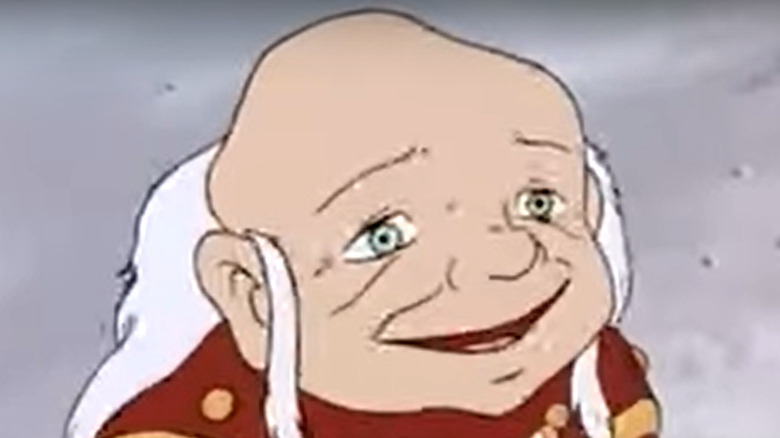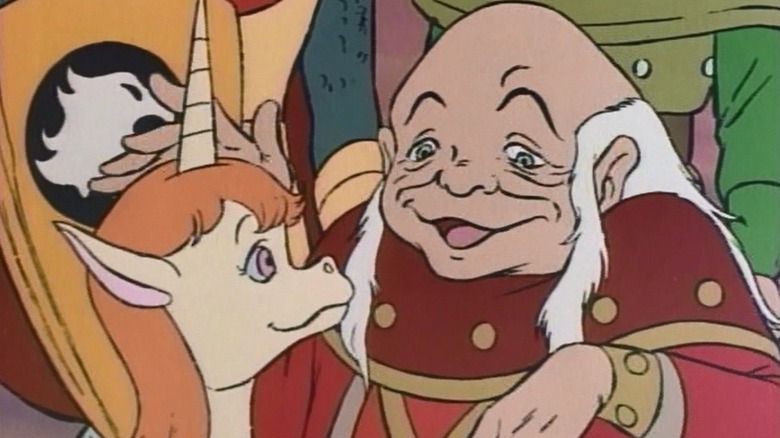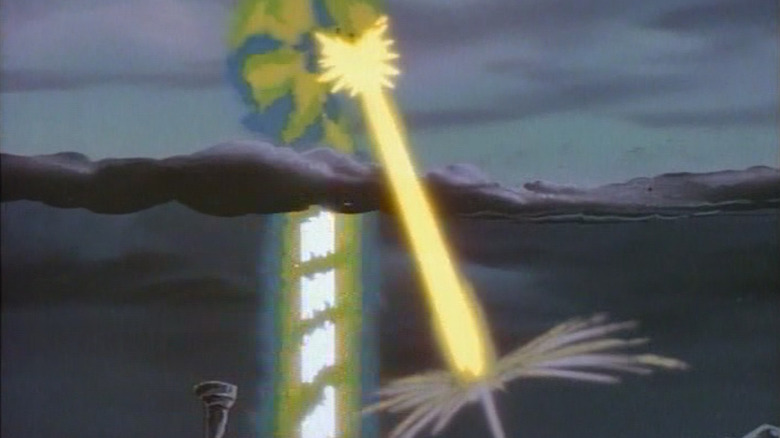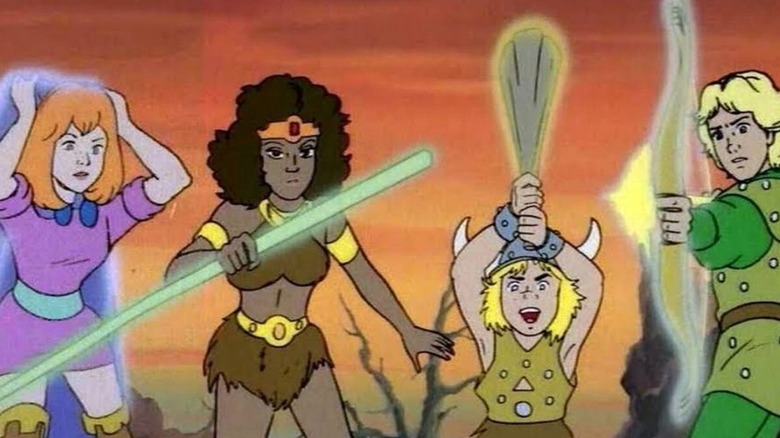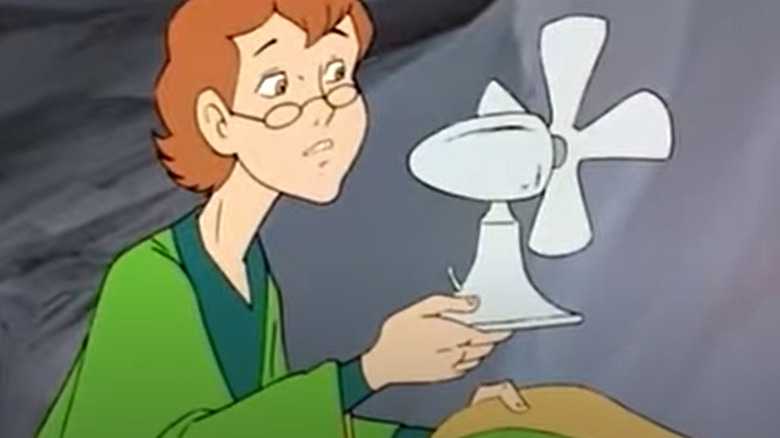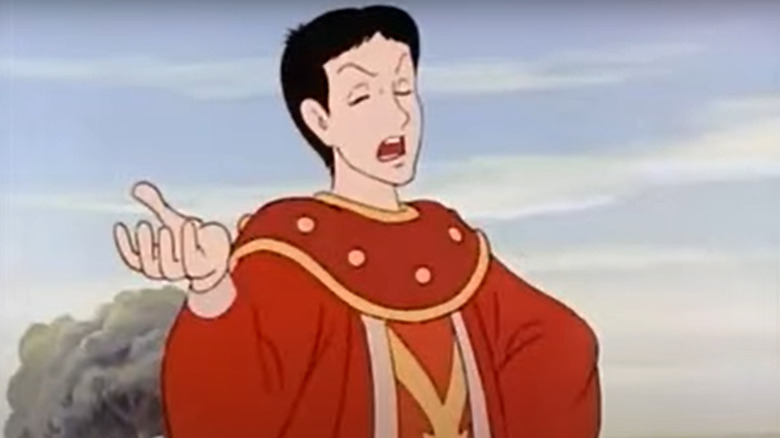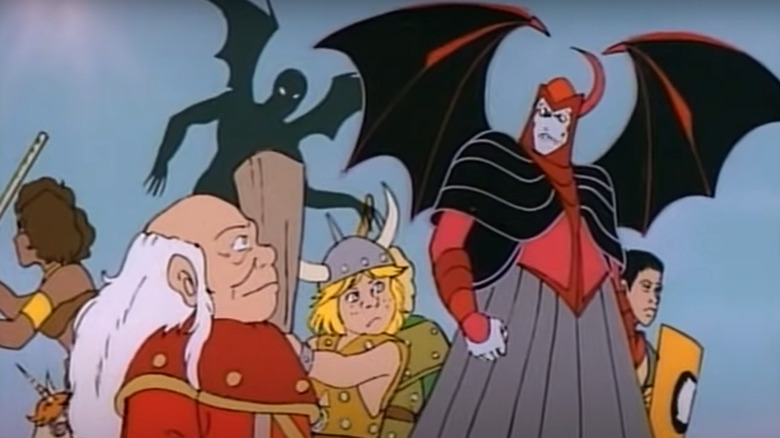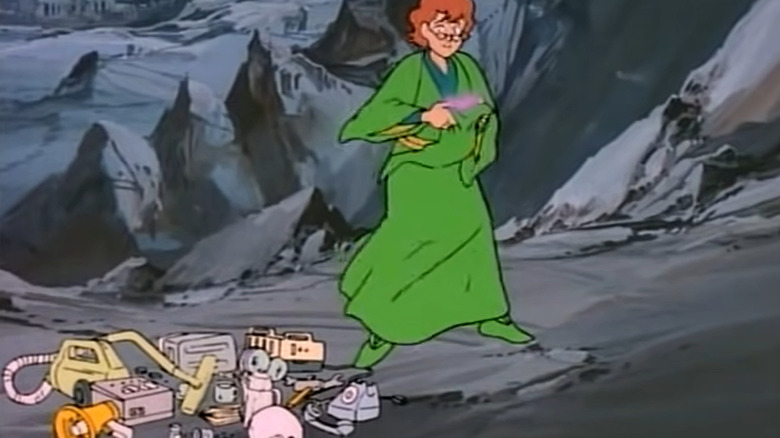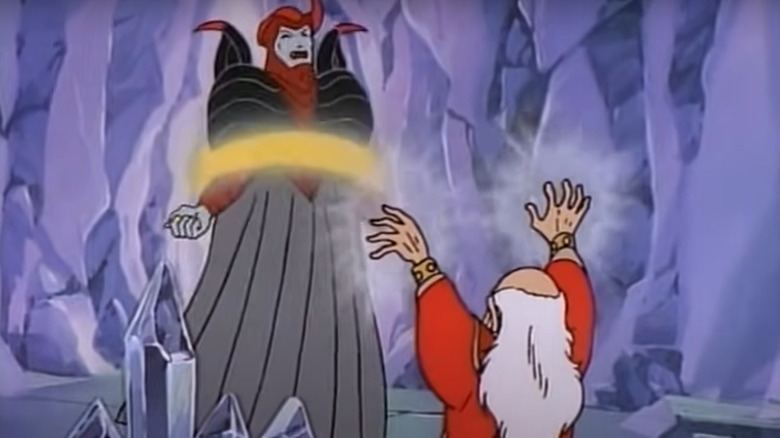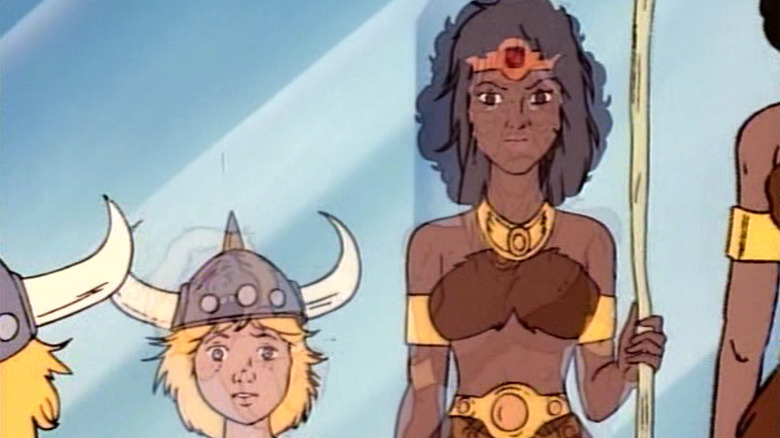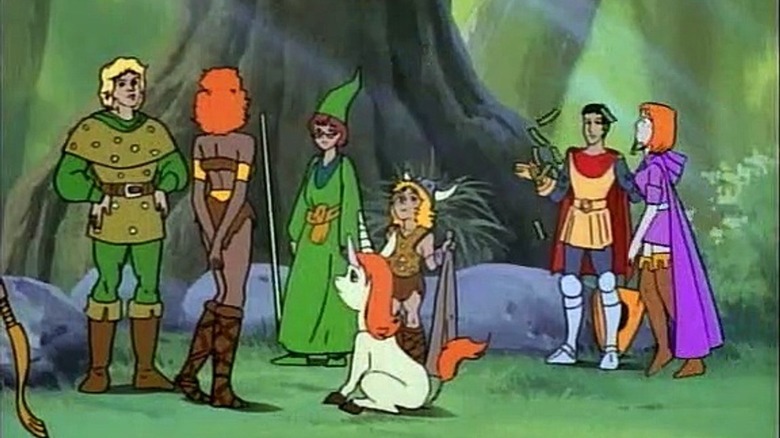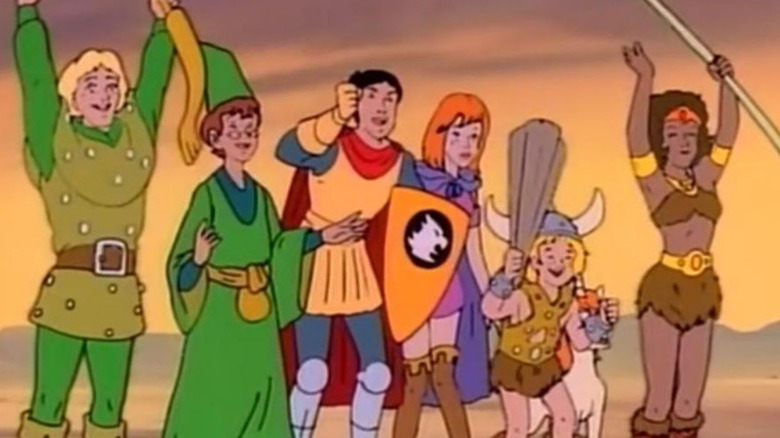Things Only Adults Notice In Dungeons & Dragons
"Dungeons & Dragons" is a game that everyone seems to know about that always seems on the brink of becoming mainstream before just stopping short. Ever since Gary Gygax and Dave Arneson developed the original "Dungeons & Dragons" tabletop role-playing game in 1974, the franchise has caught the imagination of fantasy genre enthusiasts the world over.
Following the rapid success of the tabletop game, efforts were made to expand the franchise into other mediums, including a trilogy of unrelated films. One of the earliest attempts in that direction was the creation of an animated "Dungeons & Dragons" series. It ran for three seasons on CBS from 1983 to 1985 before ending prematurely before the series finale was ever produced. The animated story follows a group of young heroes named Hank, Eric, Diana, Sheila, Presto, and Bobby.
One day, the group is mysteriously teleported to a magical land full of, you guessed it, dungeons, dragons, and various other fantasy genre mainstays. The teens are guided by a mysterious being called the "Dungeon Master" and granted various magical weapons to battle the evil sorcerer Venger so they can return to their homeworld. In later years, the show has become a cult classic. Here are some things in the show that you might not have realized as a young fan.
The Dungeon Master is no friend to the kids
When the main characters accidentally stumble into a new realm of magic, they are greeted by a short, white-haired, and red-robed figure who calls himself "Dungeon Master." It is this mysterious figure who gifts the teens their magical weapons and promises to guide them through the realm until they can find a way back home.
The Dungeon Master is clearly meant to be like Yoda or Gandalf — a wise and powerful mentor who helps the heroes grow stronger and aids them in their quest. But is Dungeon Master really such a benevolent figure? Guys like Luke Skywalker and Frodo Baggins were given their quests by someone else, and Yoda and Gandalf simply aided them along the way. But in Dungeon Master's case, it is he who assigns Hank and the others the quest of taking down Venger.
He basically forces this quest on the kids and blackmails them with promises of helping them get home if they defeat Venger. In the final, unproduced episode of the series, it is revealed that Dungeon Master always had the power to send the kids back home but chose not to so he could use a bunch of inexperienced teens to fight a powerful, centuries-old sorcerer. The Dungeon Master wasn't the kids' mentor — he was their puppet master.
The influence of H.P. Lovecraft
The main villain of "Dungeons & Dragons" is Venger, a powerful and evil sorcerer who seeks to conquer everything in his path. But as scary as Venger is, an even greater threat is The Nameless One. The character shows up in the episode "The Dungeon at the Heart of Dawn," and Venger reveals that his own power was granted to him by The Nameless One so he could conquer the realm in his master's stead.
When Venger fails to do so, The Nameless One personally arrives to take care of business. It is depicted as a giant tornado of fury and power whose face is too terrible to be looked upon. The Nameless One is too overwhelmingly powerful for anyone in the show — from the heroes to the villains — to even think about stopping or defeating. It simply leaves at the end of the episode to terrorize other realms.
The nature of The Nameless One — from its title to its power to the fact that its physical form is considered too much for the human mind to comprehend — all bear a striking similarity to "The Great Old Ones," which are ancient Eldritch gods mentioned in horror icon H.P Lovecraft's stories. Lovecraft's characters have become popular figures in fantasy mythology, and the "Dungeons & Dragons" game is known for using Lovecraft's creations for inspiration (though not anymore, according to Comic Book Resources). It's not such a far reach to imagine the show was also inspired by the same source in the creation of The Nameless One.
The weapons are not used properly
The most badass part of "Dungeons & Dragons" is the array of magical weapons that the kids are given to help them defeat Venger and find a way home. Hank gets a bow with energy arrows, Eric gets a shield that can stop any attack, Diana gets an extendable staff, Sheila gets an invisibility cloak, Presto gets a magician's hat, and Bobby gets a powerful club.
Obviously, the weapons capable of doing the most damage are Hank's bow and Bobby's club. Either of these weapons can be used to make short work of many of the minor villains the group runs into from time to time. And yet, neither the bow nor the arrow is ever used for truly destructive purposes. The few times Hank or Bobby directly attack a villain with their weapons, it's against much bigger opponents, and they have no effect.
This sort of non-violent combat was necessitated by the censors, who did not want children watching a show where the hero shoots an arrow through the body of a villain or clubs them to death. As a result, the show had to think of non-bloody ways for Hank and Bobby to use their weaponry, like when Hank's arrow becomes a rope to tie the villain up with or when Bobby knocks down the roof to trap villains.
Presto's hat is sentient and wicked
Despite being mere teens, the characters in "Dungeons & Dragons" are expected to figure everything out on their own in their quest to defeat Venger. We have already spoken about how Dungeon Master is not truly a friend to the kids. For example, he always speaks in riddles that the kids have trouble deciphering instead of just giving them the information they need as a responsible adult would.
Another way the Dungeon Master screws over the kids is when he gives Presto a magic hat that can create anything. On paper, the hat seems like it could be extremely useful, but Presto always has great difficulty getting it to work properly. When Presto asks his hat to call Venger to fight their mutual enemy Kalak, it transports him to Venger's castle, where the evil sorcerer comes very close to killing Presto on the spot.
Based on its actions, it is clear that the hat is sentient and either has a twisted sense of humor or is straight-up evil. It frequently provides useless things in times of dire need that almost get the group killed, like a cannonball without a cannon to fire it from. The hat almost feels like a diabolical genie that the Dungeon Master gave to Presto as a practical joke.
Eric has family issues
In the main group of heroes in "Dungeons & Dragons," Eric is clearly meant to be the least likable one. He is always the first one to complain, the most reluctant hero, likes to boast about how rich his family is in his other life, and is highly sensitive about being the butt of jokes.
We don't get a lot of information about Eric's past life, but in the episode "City at the Edge of Midnight," we do get an important hint through a mysterious traveler named Ramoud. At the end of the episode, Ramoud is revealed to be an immensely wealthy king who gave up his position to search for his daughter in the desert all by himself. Upon learning about Ramoud's true nature, Eric notes that the disguised king is a better parent than his own father ever was.
Clearly, Eric has a wealthy but neglectful father who does not give his son the attention he deserves. This explains Eric's many insecurities and his desire to hide them under a false sense of bravado and cruelty to others. Fortunately, being around the other heroes and experiencing their tried-and-true friendship in the face of mortal danger changes Eric for the better, and he grows into a brave and noble hero willing to put the well-being of others above his own.
The Dungeon Master only truly cares about Venger
We've already established that Dungeon Master's main motive is not helping the children. The old man is playing a deeper game based around a secret mission that the children know nothing about. We get a hint of this in a scene where the main group of heroes is speculating about the possibility of there being some good in their arch-enemy Venger.
When Eric dismisses the possibility outright, the Dungeon Master's eyes fill with tears. He states that there was good in Venger a long time ago, adding, "Everyone makes mistakes. Venger was mine." Clearly, there's more to the Dungeon Master's relationship with Venger than being sworn enemies, and the meaning of Dungeon Master's words is made clear in the final, unproduced episode of the show that never made it to air. The script for the episode ends with the revelation that Venger is Dungeon Master's son, who was lured into the service of The Nameless One long ago.
As part of the pact, all the goodness Venger possessed was removed from him, turning him into the cruel tyrant the world came to know. After Venger is returned to his regular self by the main group of heroes, the Dungeon Master offers them the chance to return home on the spot. That means Dungeon Master always had the power to send the children home anytime he wanted, but he chose to keep them trapped in his realm just to aid him in saving Venger.
The way back was obvious all along
While the main heroes in "Dungeons & Dragons" have various tasks that need to be accomplished in every episode, the main quest is always finding a way back to their home realm. This is the main motivation behind the heroes working alongside Dungeon Master, who promises he will help them get home eventually.
Sometimes the heroes get very close to finding a portal to take them back home, only for the portal to close or get destroyed before they can enter it. One or two times, the heroes are actually able to make it to the other end, only to return to Dungeon Master's realm due to various complications. And yet, one portal connecting the children back to their homeworld is in their possession all along — Presto's magic hat. We often see Presto draw objects from the hat that clearly belong to their home realm, like a telephone or a vacuum cleaner.
We also know the hat is powered by the Dungeon Master, who has the power to send the children back to their realm any time he wants. These two points make it obvious that Presto's hat is capable of opening some sort of portal back to the heroes' home. But Presto and the others never figured out the hat could be used in such a manner, and the Dungeon Master sure wasn't going to tell them about it until his mission to save Venger was completed.
Venger sounds like an evil Optimus Prime
Many fans have noted how much scarier "Dungeons & Dragons" was than kids' shows of its time. Despite not being allowed to show much violence onscreen, the makers of the show managed to produce some genuine scares. The desperation with which the children try to get back home, the many times they narrowly avoid death, and the scary nature of the villains are all used to chilling effect.
The scariest villain on the show is also the main antagonist, the demonic sorcerer Venger. With his tall, gaunt figure, complete with fangs, bat-like wings, and a single horn, Venger's appearance is enough to strike terror into the hearts of audiences. But it's his cold and chilling voice that makes Venger truly terrifying. This is doubly impressive when you consider that it's the same voice used for Optimus Prime.
Venger's voice actor is celebrated performer Peter Cullen, beloved by fans for being the voice of Optimus Prime in the "Transformers" cartoon series and later the live-action movies. Cullen has the rare distinction of playing one of the greatest children's heroes of the 1980s cartoon series lineup, as well as one of the greatest villains.
Diana's real-world fear
Diana is the most action-oriented character in the group. She is adventurous, curious, and always the first one to suggest a proactive path to a mission. In her homeworld, Diana is a champion gymnast, and she continues to use these abilities thanks to her indestructible magical staff that can grow longer or shorter.
In one episode, the heroes are faced with their worst fears. In the case of Diana, it turns out that her worst fear is growing old and weak. This fear makes sense if you consider Diana's strong and independent nature and her distaste for relying on other people to survive. But it makes even more sense when you consider her background — in the real world, being a champion gymnast is a pretty short career opportunity.
The nature of the profession and its intense demands on the body means that only very young athletes are able to perform at their peak as gymnasts, and they often have to retire from the sport before turning 30. For Diana, growing old before her time must be a terrifying proposition because it means she will no longer be able to do the one thing she loves and can do better than anyone else.
The unending squabbling
While the main heroes in "Dungeons & Dragons" are mighty warriors blessed with fantastic abilities, they rarely act like it. Instead, they spend the majority of each episode arguing with each other, making fun of each other's abilities, and generally doing nothing useful until the main threat arrives (or the Dungeon Master brings them in line).
This sort of behavior is not expected of heroes, but you have to remember that the characters on the show are in their teens, with the youngest, Bobby, being less than 10 years old. It is natural that characters who are essentially still children are not able to act like a seasoned team of warriors who have had time to mature and become disciplined.
On a meta-level, the non-stop squabbling between the group of heroes is pretty much exactly how a typical "Dungeons & Dragons" gameplay session actually unfolds. Players argue with each other all the time, and it is left to the Dungeon Master to maintain some sort of order to the quest. It's not very professional, but the main characters on the show give you a pretty good idea of what it feels like to play a session of "D&D" with your friends.
Each hero gets a personal arc
A really good "Dungeons & Dragons" quest isn't just about completing a random set of tasks in a magical realm but also going on an emotional journey with your character in the game. Something similar happens in the "D&D" animated series, where each of the five main heroes goes on personal journeys through the three seasons.
Hank the Ranger feels the weight of responsibility as the oldest member of the group. He has to learn to accept his position as leader despite the pressures the position places on him. Elsewhere, Eric the Cavalier has to learn to let go of his selfish impulses and become a true hero willing to sacrifice his own needs for the sake of others.
Diana the Acrobat has to confront her fears of getting old and weak and learn to work within a team instead of trying to do everything on her own. Meanwhile, Presto the Magician has to learn self-confidence in order to harness the true power of his magic hat. Then we have Sheila the Thief, who learns over the course of the show that her nurturing instinct toward her teammates is a source of strength rather than weakness. Finally, Bobby the Barbarian has to learn to control his temper in the face of adversity.
